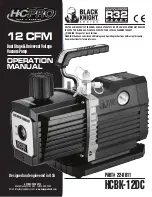
53
Line lengths 12 to 30 m:
1.
Connect hose between pressure gauge set and
refrigerant bottle.
Evacuate hose and pressure gauge set.
2.
Top up with the required amount of refrigerant: See
table below.
!
Please note
Escaping refrigerant will cause environmen-
tal pollution.
Extract refrigerant from the fill hoses and
pressure gauge set.
3.
Close valves at the pressure gauge set.
4.
Undo the caps from the fill valves of the external
unit. Open both fill valves and refit the caps.
Note
Both fill valves must be open when the appliance is
switched on.
5.
Promptly undo the fill hose and shut-off valve from
the service valve of the external unit.
6.
Fit the union nut with copper cap to the service
valve of the external unit: Torque 15 to 20 Nm.
7.
Enter the amount of refrigerant topped up on the
type plate and in the operator's log.
Information for systems with a refrigerant
charge of 3.0 kg R410A or more:
■
The operator's log must be maintained.
■
An annual tightness test is mandatory.
Refrigerant charge per metre line length (for line
lengths from 12 to 30 m)
Type AWT/AWT-AC
R410A in g/m
221.A04
20
221.A05
60
221.A07
60
221.A10
60
221.A13
60
221.B10
60
221.B13
60
221.B16
60
Checking the refrigerant circuit for tightness
Danger
The refrigerant is a non-poisonous gas that dis-
places air. Uncontrolled escape of refrigerant in
enclosed spaces can result in breathing difficul-
ties and suffocation.
■
Ensure adequate ventilation in enclosed
spaces.
■
Always observe regulations and guidelines on
handling this type of refrigerant.
Danger
Direct contact with refrigerant can be harmful to
skin.
Wear safety goggles and protective gloves when
working on the refrigerant circuit.
Check the connections for refrigerant leaks:
■
All swaged connections of the refrigerant lines
between the internal and the external unit
■
All brazed joints and threaded fittings of the refriger-
ant lines in the internal and external units
!
Please note
Refrigerant can escape when working on the
refrigerant circuit.
Work on the refrigerant circuit must
only
be car-
ried out by a certified contractor (in accordance
with EC 842/2006 and 303/2008).
Filling and venting the secondary side
Unsuitable fill and top-up water increases the level of
deposits and corrosion. This can lead to system dam-
age.
Observe VDI 2035 regarding quality and amount of
heating water, including fill and top-up water.
■
Flush the heating system thoroughly before filling.
■
Only fill with water of potable quality.
■
If the fill and top-up water has a water hardness
greater than 16.8 °dH (3.0 mol/m
3
), it must be soft-
ened, e.g. using the small softening system for heat-
ing water: See the Vitoset pricelist.
Commissioning, inspection, maintenance
Charging the refrigerant lines and indoor unit
(cont.)
5776 028 GB
Summary of Contents for AWT 221.A04
Page 77: ...77 Maintenance Checking the fuses cont 5776 028 GB Maintenance...
Page 87: ...87 Indoor unit parts lists Indoor unit hydraulics cont 5776 028 GB Components...
Page 90: ...90 Indoor unit parts lists Indoor unit cylinder cont 5776 028 GB Components...
Page 137: ...137 Wind direction 11 Wind loads 11 Keyword index Keyword index cont 5776 028 GB...
Page 138: ...138 5776 028 GB...
Page 139: ...139 5776 028 GB...
















































